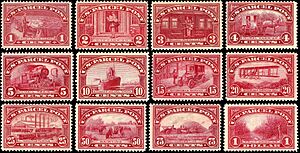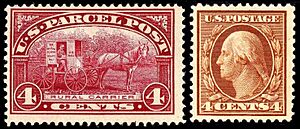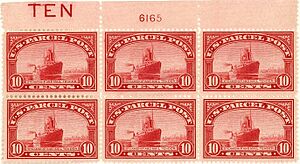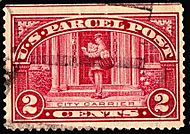U.S. Parcel Post stamps of 1912–13 facts for kids
The U.S. Parcel Post stamps of 1912–13 were special stamps used in the United States. They were the first stamps made for sending packages, called parcels. The U.S. Post Office released these stamps between 1912 and 1913.
There were twelve different stamps in the set. Each stamp had a different value, but they were all printed in the same "carmine-rose" color. Unlike regular letters, which were charged by ounces, parcels were charged by pounds. These new stamps quickly became popular. Farmers and businesses in the countryside used them a lot.
However, people sometimes got confused using them. So, after a short time, regular stamps were also allowed for sending parcels. This meant the special Parcel Post stamps were not needed as much.
Contents
How Parcel Post Stamps Were Made
Before 1912, private companies delivered most packages. These companies mostly worked in cities. This made it hard for people in rural areas, like farmers, to get supplies.
To help, the U.S. Congress passed a law on August 24, 1912. This law created a new postal service for packages, called Parcel Post. It also allowed the Post Office to make special stamps for this service. Parcel Post started on January 1, 1913.
The Bureau of Engraving and Printing made these 12 stamps. They were printed on a special machine called a flat plate press. The paper was yellowish and had a watermark that said 'U S P S'. The stamps also had small holes, called perforations, around their edges.
Designing the Stamps
A designer named Clair Aubrey Houston created the stamps. He had worked at the Bureau for ten years. Different engravers worked on the detailed pictures for each stamp.
The Post Office wanted all 12 stamps ready before January 1, 1913. But the Postmaster General, Frank Harris Hitchcock, did not like the first designs for the 3-cent, 50-cent, and 75-cent stamps. So, these stamps were released a bit later.
All the stamps were printed in the same "carmine-rose" color. Postmaster General Hitchcock thought this was a good idea. However, postal workers found it hard to tell the stamps apart quickly. This was especially true during busy times. To help, large words showing the value were added to the edges of the stamp sheets.
The Parcel Post stamps were also bigger than regular stamps. This made it tricky to fit them on smaller packages. They came in sheets of 180 stamps, which was not easy for counting. Because of these issues, some people, like stamp collectors, did not like the new stamps much.
Why Parcel Post Started
For many years, private delivery companies stopped the U.S. government from starting a parcel service. But big companies like Sears Roebuck and other mail-order stores wanted this service. They worked hard to convince Congress to create it.
Private delivery companies, like Wells-Fargo Express, saw the new government service as a threat. They tried to stop the Post Office. But in the end, the Post Office succeeded in starting its new package delivery business.
What the Stamps Showed
Special stamps were made to help keep track of money from Parcel Post separate from regular mail. The 12 Parcel Post stamps had three main themes related to the Post Office and its delivery. You could pay any amount up to one dollar using no more than three stamps. Three of the values—20 cents, 25 cents, and 75 cents—were new for U.S. stamps.
- The first four stamps (1, 2, 3, and 4 cents) showed different postal workers. These were people who sorted or delivered mail. The 4-cent stamp featured William Haliday Williams, a rural mail carrier and a hero.
- The next four stamps (5, 10, 15, and 20 cents) showed ways mail was transported. The 20-cent stamp was special because it was the first U.S. stamp to show an airplane. This was six years before the Post Office started airmail service. The 10-cent stamp shows the ship SS Kronprinz Wilhelm in New York Harbor.
- The last four stamps had the highest values (25, 50, and 75 cents, and 1 dollar). They showed different industries that would use the new service a lot. The 25-cent stamp shows a real steel plant. The highest value stamps were made in smaller numbers because fewer people needed them.
When Stamps Were Issued and How Many
| Value | Picture | First day of issue | Number made |
|---|---|---|---|
| 1 cent | Post office clerk | Nov. 27, 1912 | 209,691,094 |
| 2 cents | City carrier | Nov. 27, 1912 | 206,417,253 |
| 3 cents | Railway postal clerk | April 5, 1913 | 29,027,433 |
| 4 cents | Rural carrier | Dec. 12, 1912 | 76,743,813 |
| 5 cents | Mail train | Nov. 27, 1912 | 108,153,993 |
| 10 cents | Steamship and mail tender | Dec. 9, 1912 | 56,896,653 |
| 15 cents | Automobile service | Dec. 16, 1912 | 21,147,033 |
| 20 cents | Airplane carrying mail | Dec. 16, 1912 | 17,142,393 |
| 25 cents | Manufacturing | Nov. 27, 1912 | 21,940,653 |
| 50 cents | Dairying in America | March 13, 1913 | 2,117,793 |
| 75 cents | Harvesting | Dec. 18, 1912 | 2,772,615 |
| 1 dollar | Fruit growing | Jan. 3, 1913 | 1,053,273 |
Postage Due Stamps
Along with Parcel Post stamps, Congress also approved "postage due" stamps. These were used if a package did not have enough postage. The postmaster would put these stamps on, and the person receiving the package had to pay the extra amount.
How the Stamps Were Used
The Parcel Post service was very popular in its first six months. Over 300 million packages were sent! But postal workers found the special stamps confusing. So, the Postmaster General decided that regular stamps could also be used for parcels. This started on July 1, 1913.
After this, Parcel Post stamps could be used for any type of mail until they ran out. This was the only time in history that a series of stamps was allowed to be used for two different purposes. The last Parcel Post stamps were printed in June 1913. However, some higher value stamps were still sent to post offices as late as 1921. Even though the Parcel Post stamps were stopped, the 20-cent value was very useful. So, a 20-cent stamp was added to the regular Washington–Franklin stamp series.
When Parcel Post stamps were stopped, the need for Parcel Post Postage Due stamps also ended. They were not used much because most packages were paid for correctly. But like the Parcel Post stamps, they were used as regular postage due stamps until they were all gone. Some were even used into the 1920s. The 25-cent postage due stamp was especially helpful.
Almost anything could be mailed by Parcel Post, as long as it was not dangerous. People even mailed baby alligators and honey bees! (Later, fragile items like these needed extra "special handling" stamps.) This new service helped farmers and others in rural areas get things they could not buy nearby. It also helped big mail-order companies like Sears Roebuck and Montgomery Ward grow.
Other Stamp Details
The Parcel Post stamps were printed using a "flat plate" press. This created "plate blocks" of six stamps. These blocks had a plate number on the edge, which showed which printing run they came from. Starting in January 1913, the value of the stamps was also printed in words on the edge of the sheet.
Special Proofs
Special versions of the 1912–13 Parcel Post stamps were made for the Panama–Pacific International Exposition in San Francisco in 1915. These are called Die Proofs. They were printed one at a time directly from the metal plates used to make the stamps. Because of this, die proofs do not have perforations (the small holes) around them.












